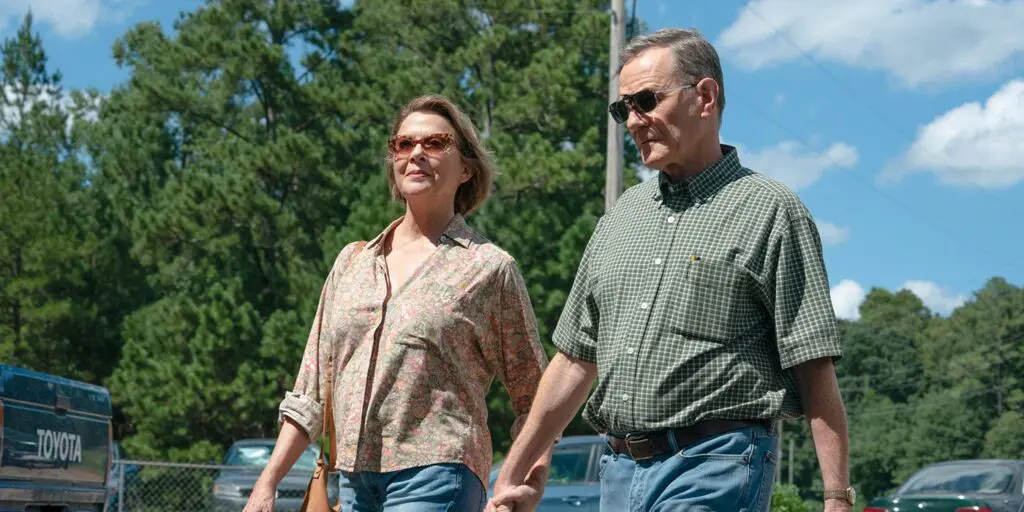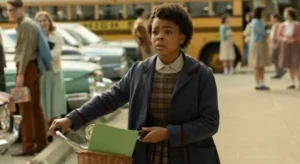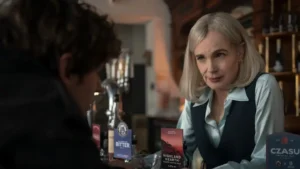Summary
Despite the joy of watching Bryan Cranston “breaking good,” Jerry & Marge Go Large falls apart under the weight of putting a premium on feel-good storytelling.
The death of small-town America has been an issue since the Great Recession. You have your basic conservatism sparked by lower wages, declining industries, and children moving away to find jobs. Then you have the ones that stay behind, who are too afraid to make their money work harder for them.
The dying sense of community has been deteriorating in middle America. That’s the premise of Jerry & Marge Go Large. It is a feel-good film about a man who has to retire from his factory job when the line closes. That man then finds a loophole in the lottery to help save his town. So basically, it’s a showcase for Bryan Cranston (Your Honor; The One and Only Ivan; Wakefield; Breaking Bad) to start breaking good.
It’s a tantalizing idea. Who hasn’t thought about winning the lottery and winning millions? However, that’s what makes Jerry Selbee (Cranston) different. He has saved a modest nest egg for himself and his wife, Marge (Annette Bening, Film Stars Don’t Die in Liverpool).
Jerry is a pragmatist. He rarely does anything he cannot explain with a logical mathematical equation, and he calculates the risk. Jerry won’t let his accountant/travel agent (played by Larry Wilmore) invest in aggressive stocks because the risk is too big. Jerry wants to stay at his two percent.
However, when Jerry finds a loophole in Michigan’s “Windfall” lottery, he figures out that the more he bets during a “roll-down,” the better odds he has of winning. When Jerry admits to gambling with their life savings, Marge is surprisingly up for it. Why? Because she wants to stop watching Jeopardy and start living life again. (Frankly, If you’re not given a head rush from the show’s adrenaline-pumping theme song from the TV Theme Band or by the whimsical categories of Rhyme Time, Before & After, 4-Letter Words, and Potpourri, you’re just a miserable son of a bitch).
When their home state closes the game, they must travel to Massachusetts. From there, they play and involve the entire community in their enterprise because their friends have hit hard times.
Based on Jerry Fagone’s article, there is much to like about David Frankel’s (Marley & Me) feel-good film, based on a true story. For one, Bryan Cranston is very good here. Where you see Cranston seething as stoically as Walter White, he brings that same stoic gravitas.
Except here it’s from a place of goodwill. You watch the wheels turn as he is always figuring out the best solution for problems. When he begins to break free from his comfort zone, watching Cranston’s Selbee bubble with nervous excitement is an absolute joy.
Genuine endearment is generated as he wants his family and community to benefit. It’s rare nowadays to have a mainstream film operate from the perspective of lending a helping hand without being too contrived.
The film catches the essence of Jerry and Marge, even though the community building is more altruistic than the facts of Fagone’s article, which are laid out there. Brad Copeland’s (Wild Hogs) film falters in the third act.
The film’s villain, Tyler (played by Uly Schlesinger), is a cocky MIT student. He also figured out the loophole that was used to enhance Jerry’s almost obscene pious nature. Jerry confronts Tyler and destroys his plan when he exposes him to his team. How? He shows them how little he cares about them compared to the community back in Michigan.
It’s a saccharine scene since Tyler’s fellow students are not doing this for free and are being paid. For the nation’s best and brightest, they need lessons in separating emotions. Why let millions slip away because Tyler didn’t hand out gift cards and pick an employee of the month? We are to believe they abandoned a plan to make millions because they didn’t get a “That’s a boy!” Jordan Belfort’s crew would smack these kids in the back of the head, tell them to make money first, and talk about their feelings later.
Another complaint is that the script never gets too detailed in Jerry’s revelation from the lottery, not trusting the audience enough to learn his genius. The final scene offers a far too neat ending that goes quickly for manipulative heartstrings.
There is nothing wrong with that, but the film, up to that point, did an excellent job of generating enough suspense as both groups race to capitalize on the next roll-down. It was a missed opportunity.
For those looking for a movie that looks at community interaction through a positive lens, Frankel’s film delivers enough comfort food tropes that fans will enjoy. However, a much more exciting movie is at hand here that even features the famed Spotlight reporting at the Boston Globe, as well as the greed from the lottery side. Despite the joy of watching Bryan Cranston “breaking good,” Jerry & Marge Go Large falls under the weight of putting a premium on feel-good storytelling.
Read More: Jerry & Marge Go Large Ending Explained




